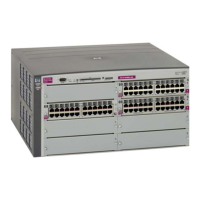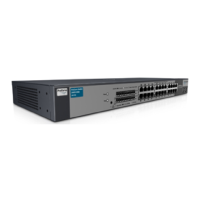Configuration Commands 106
The following table describes the Spanning Tree Port Configuration commands.
Table 109 Spanning Tree Port Configuration commands
Command Description
spanning-tree stp {<1-128>}
priority {<0-255>}
Configures the port priority. The port priority helps determine which
bridge port becomes the designated port.
In a network topology that has multiple bridge ports connected to a
single segment, the port with the lowest port priority becomes the
designated port for the segment.
The range is 0 to 255, and the default is 128.
RSTP/MSTP: The range is 0 to 240, in steps of 16 (0, 16, 32...) and
the default is 128.
Command mode: Interface port
spanning-tree stp {<1-128>} path-
cost {<1-200000000>}
Configures the port path cost. The port path cost is used to help
determine the designated port for a segment. Generally speaking, the
faster the port, the lower the path cost.
The range is 1 to 65535. The default is 10 for 100Mb/s ports, and
1 for Gigabit ports. A value of 0 indicates that the default cost will be
computed for an auto-negotiated link speed.
RSTP/MSTP: The range is 1 – 200000000, and the default it 20000
for Gigabit ports.
Command mode: Interface port
spanning-tree stp {<1-128>} link
{auto|p2p|shared}
Defines the type of link connected to the port, as follows:
auto: Configures the port to detect the link type, and automatically
match its settings.
p2p: Configures the port for Point-To-Point protocol.
shared: Configures the port to connect to a shared medium (usually a
hub).
This command only applies when RSTP is turned on. See the
“Common Internal Spanning Tree configuration” section for more
information.
Command mode: Interface port
[no] spanning-tree stp {<1-128>}
edge
Enables or disables this port as an edge port. An edge port is not
connected to a bridge, and can begin forwarding traffic as soon as
the link is up. Configure server ports as edge ports (enabled).
This command only applies when RSTP is turned on. See the
“Common Internal Spanning Tree configuration” section for more
information.
Command mode: Interface port
spanning-tree stp {<1-128>}
fastforward
Enables or disables Port Fast Forward on the port.
Command mode: Interface port
spanning-tree stp {<1-128>} enable
Enables STP on the port.
Command mode: Interface port
no spanning-tree stp {<1-128>}
enable
Disables STP on the port.
Command mode: Interface port
show interface port {<port number>}
spanning-tree stp {<1-128>}
Displays the current STP port parameters.
Command mode: All
Forwarding Database configuration
The following table describes the Forwarding Database Configuration commands.
Table 110 FDB Configuration commands
Command Description
aging <0-65535> Configures the aging value for FDB entries. The default value is 300.
show mac-address-table Displays current FDB parameters.

